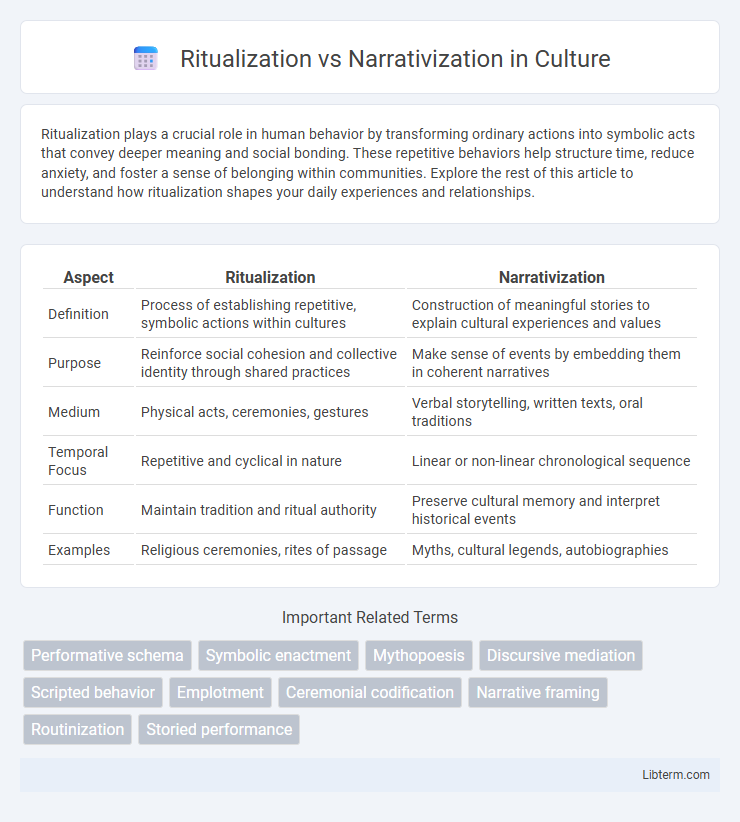Ritualization plays a crucial role in human behavior by transforming ordinary actions into symbolic acts that convey deeper meaning and social bonding. These repetitive behaviors help structure time, reduce anxiety, and foster a sense of belonging within communities. Explore the rest of this article to understand how ritualization shapes your daily experiences and relationships.
Table of Comparison
| Aspect | Ritualization | Narrativization |
|---|---|---|
| Definition | Process of establishing repetitive, symbolic actions within cultures | Construction of meaningful stories to explain cultural experiences and values |
| Purpose | Reinforce social cohesion and collective identity through shared practices | Make sense of events by embedding them in coherent narratives |
| Medium | Physical acts, ceremonies, gestures | Verbal storytelling, written texts, oral traditions |
| Temporal Focus | Repetitive and cyclical in nature | Linear or non-linear chronological sequence |
| Function | Maintain tradition and ritual authority | Preserve cultural memory and interpret historical events |
| Examples | Religious ceremonies, rites of passage | Myths, cultural legends, autobiographies |
Understanding Ritualization: Definition and Significance
Ritualization refers to the process by which actions or behaviors are structured into formalized, repetitive patterns imbued with symbolic meaning, crucial for fostering social cohesion and cultural identity. This process anchors individuals within a communal framework, emphasizing shared values and collective memory through prescribed ceremonies and practices. Understanding ritualization is essential for analyzing how societies maintain continuity and transmit intangible cultural heritage across generations.
What is Narrativization? Origins and Concepts
Narrativization refers to the process of structuring events or experiences into a coherent narrative or story, enabling individuals and cultures to make sense of complex realities. Originating from disciplines such as anthropology, psychology, and literary theory, narrativization emphasizes the role of storytelling in shaping memory, identity, and social meaning. Central concepts include plot development, temporal sequencing, and thematic coherence, which transform disparate occurrences into meaningful narratives.
Key Differences Between Ritualization and Narrativization
Ritualization emphasizes repetitive, symbolic actions performed within cultural or social contexts to reinforce shared values and group identity, often involving ceremonies or traditional practices. Narrativization centers on constructing and interpreting stories or narratives to make sense of experiences, providing coherence and meaning to events over time. Key differences include ritualization's focus on enacted behavior and collective participation, while narrativization prioritizes cognitive processes and the organization of information into chronological or thematic sequences.
Historical Evolution of Ritualization and Narrativization
The historical evolution of ritualization reveals its roots in ancient societies where repetitive symbolic actions reinforced social cohesion and cultural norms, predating formal storytelling traditions. Narrativization emerged later as communities began to structure experiences into coherent stories, enabling the preservation and transmission of collective memory through generations. Together, these processes reflect the human inclination to create meaning, with ritualization emphasizing embodied practice and narrativization focusing on linguistic and cognitive frameworks.
Roles in Cultural and Social Practices
Ritualization involves established roles that guide participants through symbolic actions reinforcing communal identity and shared values, often emphasizing repetition and formality. Narrativization assigns roles within storytelling frameworks, enabling individuals to interpret, communicate, and transmit cultural meanings through personal and collective narratives. Both processes shape social cohesion by structuring behavior and meaning, with ritualization emphasizing enactment and narrativization focusing on representation.
Psychological Impacts: Ritualization vs Narrativization
Ritualization fosters psychological stability by creating predictable patterns that reduce anxiety and enhance a sense of control, grounding individuals in shared cultural practices. Narrativization shapes identity through meaning-making processes, allowing individuals to integrate experiences into coherent personal or collective stories that promote emotional coherence and resilience. Both mechanisms contribute uniquely to mental well-being by balancing structured behavioral repetition with evolving cognitive interpretation.
Ritualization in Religion, Society, and Daily Life
Ritualization in religion manifests through structured ceremonies and liturgies that reinforce communal beliefs and spiritual identities, such as the Catholic Mass or Hindu puja. In society, ritualization functions as a means of establishing social cohesion and order, evident in rites of passage like weddings, graduations, and national holidays that reaffirm collective values. Daily life incorporates ritualization through habitual practices and routines, like morning prayers or cultural greetings, which foster a sense of continuity and personal grounding.
Narrativization in Storytelling, Media, and Communication
Narrativization in storytelling, media, and communication transforms events and experiences into structured narratives that provide meaning, coherence, and emotional engagement for audiences. It organizes information through plot development, character arcs, and thematic elements, enhancing audience retention and interpretation across diverse platforms such as film, journalism, and digital media. This process supports cultural transmission and identity formation by framing individual and collective experiences within accessible and relatable story formats.
Intersections: How Ritualization and Narrativization Overlap
Ritualization and narrativization intersect through their shared function of structuring human experiences by embedding symbolic meaning into social practices and stories. Both processes utilize repetitive, formalized actions and narrative frameworks to reinforce cultural values, collective memory, and identity construction. This overlap enables communities to sustain continuity and coherence by linking ritual acts with narrative interpretation, shaping individual and group understanding.
Future Perspectives: The Changing Dynamics of Rituals and Narratives
Future perspectives on ritualization and narrativization emphasize their evolving roles in digital cultures and virtual environments, where immersive technologies amplify participatory experiences and collective memory formation. Emerging trends reveal a convergence of rituals and narratives through augmented reality and AI-driven storytelling, reshaping social cohesion and identity construction in decentralized networks. This dynamic interplay suggests a transformation in how traditions and histories are performed and communicated, highlighting the importance of interdisciplinary research in digital anthropology and media studies.
Ritualization Infographic

 libterm.com
libterm.com